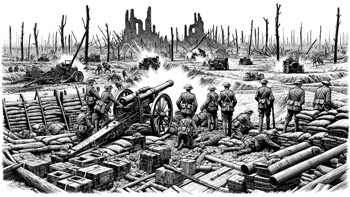World War I, also known as the Great War, was a global war centered in Europe that began on July 28, 1914, and lasted until November 11, 1918. It involved many of the world's great powers, divided into two opposing alliances: the Allies and the Central Powers. The war marked a turning point in world history, leading to significant political, cultural, and social changes.
The Spark That Ignited the War
The immediate cause of World War I was the assassination of Archduke Franz Ferdinand of Austria-Hungary by a Serbian nationalist in June 1914. This event set off a chain reaction of alliances and mobilizations, leading to the outbreak of war. The deeper causes, however, lay in the complex interplay of nationalistic aspirations, militarism, imperial ambitions, and a system of alliances that divided Europe into competing camps.
The Major Battles and Campaigns
The war was characterized by several significant battles and campaigns. The Battle of the Marne, fought in 1914, halted the German advance into France and set the stage for trench warfare. The Battle of Verdun and the Battle of the Somme, both in 1916, saw unprecedented levels of casualties and demonstrated the war's brutality. The war also saw battles in Eastern Europe, the Middle East, and Africa, expanding its impact globally.
Technological Advancements and Warfare
World War I saw many technological innovations in warfare. The use of machine guns, poison gas, tanks, and aircraft changed the nature of combat and resulted in high casualties. Trench warfare became a defining feature of the war, with soldiers living in difficult conditions and facing a constant threat of enemy fire.
The Home Front and Civilian Impact
The war had a profound impact on civilians. Governments mobilized economies for war production, leading to shortages and rationing of resources. Propaganda campaigns were widespread, aiming to maintain public support for the war. The conflict also caused significant social changes, including the role of women in the workforce and shifts in social attitudes.
The Global Impact and New Nations
World War I reshaped the world map, leading to the collapse of empires and the creation of new nations. The Russian Revolution in 1917 led to the rise of the Soviet Union. The war's end saw the dissolution of the Austro-Hungarian and Ottoman empires, leading to the creation of several new countries in Europe and the Middle East.
The Treaty of Versailles and Its Consequences
The war concluded with the Treaty of Versailles in 1919, which imposed heavy reparations and territorial losses on Germany. The treaty's harsh terms and the sense of humiliation it fostered in Germany are often cited as factors contributing to World War II. The League of Nations was also established to prevent future conflicts, though it ultimately proved ineffective in stopping the outbreak of another world war.
The Lasting Legacy of World War I
World War I had a lasting impact on the 20th century. It transformed societies, economies, and political structures. It also marked the beginning of a new era in warfare and international relations. The war's legacy is still evident in the modern world, shaping international politics and national identities.

